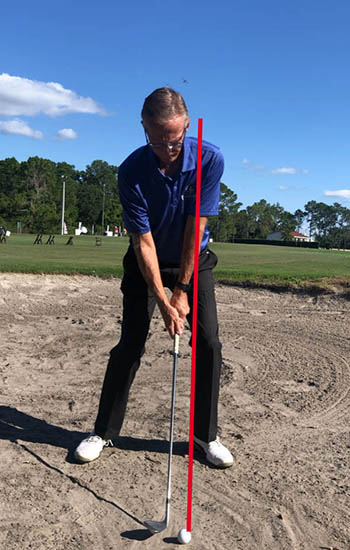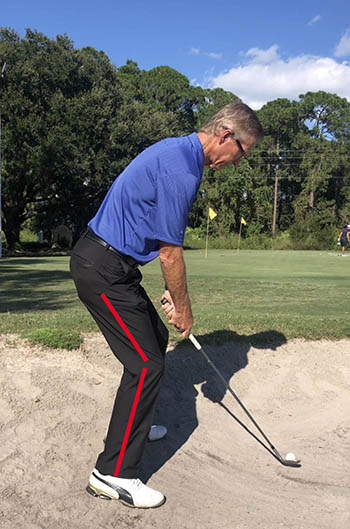How to Get Out of a Bunker

By Bradley Turner MBA, PGA
Director of Online Golf Instruction Keiser University College of Golf
The greenside bunker shot is often considered to be one of the more difficult golf shots, yet the tour professionals make it look so easy! What are the tour professionals doing that most amateur golfers don’t do on these greenside bunker shots?
Start with the Setup
The setup in every golf shot is important, but it becomes especially important when hitting a bunker shot. Except for a bunker shot, the goal in hitting a golf ball is to contact the ball before touching the ground. Therefore, the bunker shot is an exception to most golf shots. Ball position and setup become paramount for an amateur attempting to improve their bunker skills. The following are some setup adjustments you will want to implement into your bunker game.

In the face-on view (left), a slightly wider stance is preferred keeping 60%-70% of the weight on the lead foot. Your setup should have a slight spine tilt away from the target with your hands resting underneath the sternum. Keep the shaft lean between zero and two degrees. Leaning the shaft too much toward the target is a common setup error for amateurs.

Next is to use your full swing grip, BUT it is important first to open the clubface the desired amount and then grip the golf club. When you open the clubface, you increase the effective bounce of the sand wedge. More bounce is generally better for most golfers. Bounce is your friend in the bunker, so make sure you have a sand wedge with plenty of bounce. Most sand wedges will have between 10 to 14 degrees of bounce, so I am an advocate of 14 versus 10 degrees. The last important piece is to position the ball forward of the sternum. The club must enter the sand between 3” – 5” behind the golf ball. To accommodate for this, play the ball 3”-5” forward of your normal ball position for a pitch shot.

From the target line view, the tour player will be aligned slightly open to the target. Opening up too much is a very common error in the poor bunker shot technique. Next is to increase your distance away from the ball and increase your knee flex. This adjustment, combined with a wider stance, will allow for a shallower vertical swing plane angle. This will help you with hitting softer and more controlled bunker shots.
By lowering the shaft plane angle, the face plane will orient more to the left for a right-handed golfer. By opening the face and lowering the handle, the face plane will align more toward the target. This adjustment will allow for a more simplified in-swing bunker technique.
In-Swing Bunker Technique
By implementing these setup adjustments, it will be much easier to execute a quality bunker shot. The in-swing bunker technique is highly influenced by your unique golf swing. I believe you should keep the club path oriented very close to your landing target. The consensus of swinging along the foot line is acceptable as long as you are slightly open to the target in your setup! If you are too open to the target and swing along your foot line, there may not be enough energy transfer to hit anything other than a very short bunker shot. Swinging towards the landing spot is good advice. I have measured hundreds of golfers hitting bunker shots out of the sand, and the findings reveal that many golfers are unable to control the entry point of the club into the sand. The good news is all golfers have about a 2” window of error that will still allow for a good bunker shot. My findings show that ALL golfers should enter the sand 3” – 5” behind the ball. If you are consistent in making contact with the ball first in a full swing, then you can become consistent in hitting this 2” window in the sand. In fact, it should be easier in the sand since the ball is smaller than 2” in diameter!
Use the Right Equipment
Golfers that struggle with casting the club with an outside to in path will have challenges in bunker play. The best solution for this type of player is a sand wedge with high bounce and a wide flange (the bottom or sole of the club). Matching equipment to each individual swing technique is an important aspect of selecting the right sand wedge for you. The home course bunker conditions, along with your swing technique, are the two most important factors in getting the best equipment in your hands. While the greenside bunker shot is not easy despite what you may have heard, by understanding these important concepts, you will begin to move down the correct path toward better bunker play. Before you know it, you will be making bunker play look easy, just like the tour players.
If you’d like to study with Bradley Turner and other PGA Master Professionals, contact The College of Golf today.












